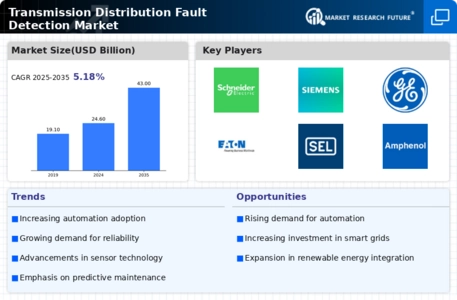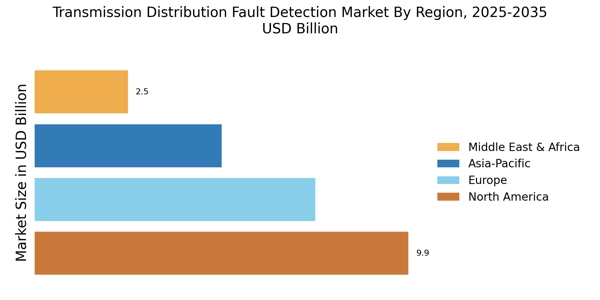Increasing Investment in Smart Grids
The transition towards smart grids is a significant driver for the Transmission Distribution Fault Detection Market. Governments and utility companies are investing heavily in modernizing aging infrastructure to improve efficiency and reliability. Smart grids facilitate better fault detection through enhanced data collection and analysis capabilities. According to industry reports, investments in smart grid technologies are expected to exceed 100 billion dollars over the next decade. This shift not only enhances the ability to detect faults but also integrates renewable energy sources more effectively. As utilities adopt smart grid solutions, the demand for advanced fault detection systems is likely to surge, reflecting the critical need for improved grid management and operational resilience.
Rising Demand for Reliable Power Supply
The increasing demand for a reliable power supply is a primary driver for the Transmission Distribution Fault Detection Market. As urbanization accelerates and populations grow, the need for uninterrupted electricity becomes paramount. This demand is further amplified by the proliferation of electronic devices and smart technologies that require consistent power. According to recent estimates, the global electricity demand is projected to rise by approximately 2.5% annually. Consequently, utilities are compelled to invest in advanced fault detection systems to minimize outages and enhance service reliability. The integration of these systems not only improves operational efficiency but also reduces maintenance costs, thereby fostering a more resilient power infrastructure. This trend underscores the critical role of fault detection technologies in ensuring that power distribution networks can meet the escalating demands of consumers.
Technological Advancements in Fault Detection
Technological advancements play a crucial role in shaping the Transmission Distribution Fault Detection Market. Innovations such as artificial intelligence, machine learning, and IoT are revolutionizing how utilities detect and respond to faults. These technologies enable real-time monitoring and predictive analytics, allowing for proactive maintenance and quicker response times. For instance, the implementation of smart sensors and automated systems has been shown to reduce fault detection times significantly. Market data indicates that the adoption of these advanced technologies could lead to a reduction in operational costs by up to 30%. As utilities strive to enhance their operational capabilities, the integration of cutting-edge fault detection solutions becomes increasingly vital, driving growth in the market.
Regulatory Pressures for Enhanced Safety Standards
Regulatory pressures are increasingly influencing the Transmission Distribution Fault Detection Market. Governments worldwide are implementing stringent safety standards and regulations to ensure the reliability and safety of power distribution systems. These regulations often mandate the adoption of advanced fault detection technologies to minimize risks associated with electrical failures. Compliance with these regulations is not only essential for operational integrity but also for avoiding potential penalties. As a result, utilities are compelled to invest in sophisticated fault detection systems that meet regulatory requirements. This trend is expected to drive market growth as companies seek to enhance their compliance strategies while ensuring the safety and reliability of their power distribution networks.
Growing Focus on Sustainability and Environmental Impact
The growing focus on sustainability and environmental impact is a notable driver for the Transmission Distribution Fault Detection Market. As concerns about climate change intensify, there is a concerted effort to reduce carbon footprints and enhance energy efficiency. Utilities are increasingly adopting fault detection technologies that support the integration of renewable energy sources, such as wind and solar. This shift not only aids in meeting sustainability goals but also enhances the reliability of power distribution systems. Market analysis suggests that investments in sustainable technologies could lead to a 20% increase in operational efficiency. Consequently, the emphasis on sustainability is likely to propel the demand for advanced fault detection solutions, aligning with broader environmental objectives.


















Leave a Comment